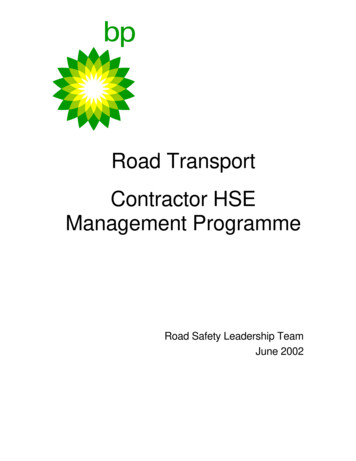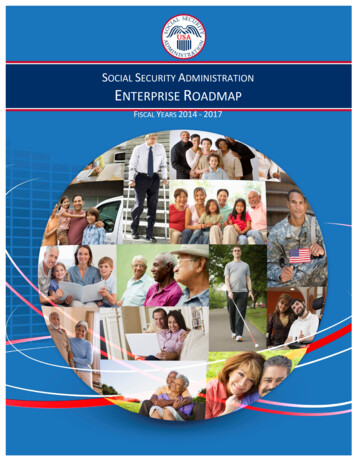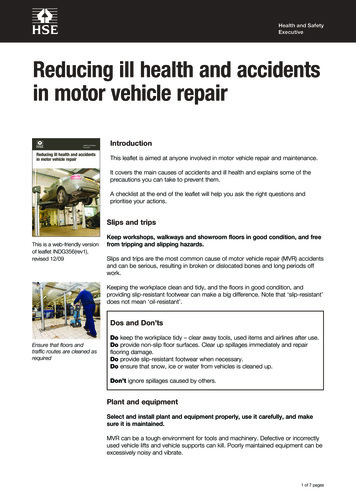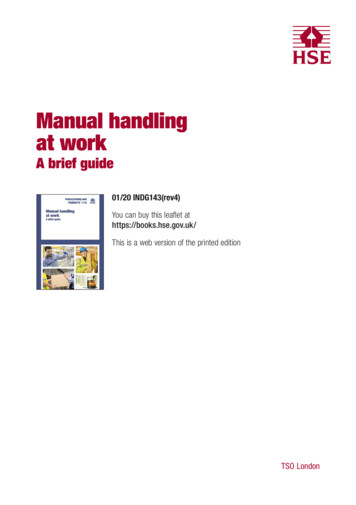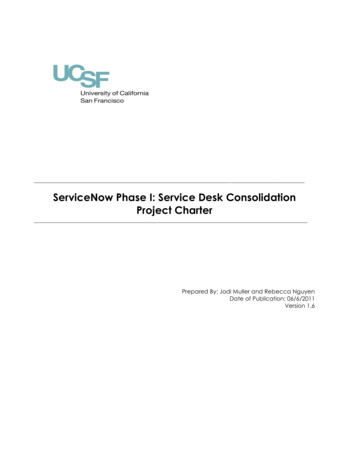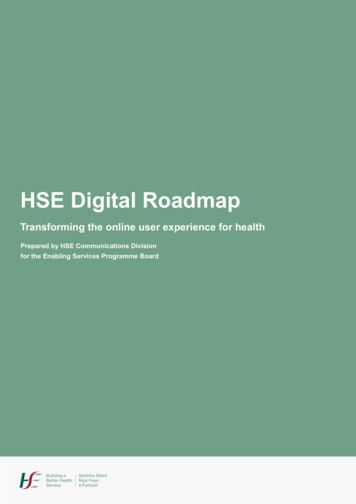
Transcription
HSE Digital RoadmapTransforming the online user experience for healthPrepared by HSE Communications Divisionfor the Enabling Services Programme BoardHSE Digital Roadmap - transforming the online user experience for health
Table of contentsContextpage 3HSE Digital Values, Vision, Mission and Principlespage 5Approachpage 6Digital auditspage 7Digital Footprint MappingContent AuditAccessibility AuditAnalytics and SEO Auditpage 12User feedbackCompetitor Analysispage 17The Solution – A Digital Experience Network for Healthpage 18What Does This Mean?page 22Public Personas – Understanding our public userspage 24Supporting Our Users’ Journeypage 26Designing Digital Health Servicespage 27Measuring Successpage 28A Digital Roadmap Aligned with Health Service Strategypage 30Digital Roadmap Implementationpage 34What we need to implement this transformationpage 35HSE Digital Roadmap - transforming the online user experience for health2
ContextDigital transformation is underway across the health service with significant investment in vitalinfrastructure projects such as the Individual Health Identifier and Electronic Health Record.This strategic roadmap is an important part of this transformation, focusing on the public facing elementsof the HSE’s digital fabric to ensure that everything we do online meets users’ needs and supports them tounderstand and navigate the health service and to manage and improve their health and wellbeing.The successful implementation of this roadmap will depend on collaboration and consultation across thehealth service with clinicians, Hospital Groups, CHOs and National Divisions. We must continue to workclosely with the OoCIO towards a shared vision of digital health in Ireland. Most importantly, we must workwith and for patients, service users and the general public to understand and ensure that we are meetingtheir digital health needs.The HSE’s current digital footprint consists of multiple websites, microsites, transactional portals and socialmedia channels. It reflects our organisational structure, not our users’ needs. It is fragmented and varies inquality from asset-to-asset.Users trying to navigate the health service, or manage their own health and wellbeing, are frustrated by notbeing able to find what they are looking for and not being able to complete their desired task easily andquickly online.We need to listen and understand our users’ needs in order to re-orient how we engage with them onlineso that we meet their needs and expectations. This step-change is crucial to the health service’s digitaltransformation. Without an accessible user-focused ‘front door’ to our digital health ecosystem, along withclear and consistent signposting, digital health service transformation will fail.In order to start this transformation, we have assessed and mapped our current digital assets, consultedwith users and key stakeholders and developed a strategic roadmap to deliver a vastly improved onlinehealth service experience.The objectives of this strategy are to: Map and evaluate the current digital footprint across the health service including websites, portals,social channels and microsites.Identify our users and their needs and define core personas and user journeys that will inform futuredevelopment.HSE Digital Roadmap - transforming the online user experience for health3
Identify key service needs and opportunities for collaboration across the health service.Identify best practice principles, guidelines and protocols to ensure the quality of future development,including SEO, accessibility, user experience and information governance.Create a strategic roadmap for the development of a high-quality, accessible digital health informationecosystem that will enable the HSE to support the public to make informed decisions in relation to theirown health and to navigate the health services. Consider the governance arrangements required for the successful delivery of the roadmap. Develop KPIs to enable us to measure our performance in implementing the roadmap.HSE Digital Roadmap - transforming the online user experience for health4
HSE Digital Values, Vision and Mission Our Values - Care, compassion, trust and learning. Our Vision - A Digital Experience Network for Health that fulfils care and trust online. Our Mission - To help our users navigate and engage with Ireland’s health services online and manageand improve their health and wellbeing.Our Guiding Principles1. Put users first – we will learn what our users need and deliver experiences that meet their needs. Weare a part of our users’ healthcare journey.2. Be personal and relevant – every engagement should be personal and relevant to the user and theircontext. Seize opportunities to cross-promote relevant content.3. Publish with care – everything we publish must be created, governed and maintained to be accurate,consistent, and of the highest possible quality.4. Consider the ecosystem - every element of the ecosystem affects the entire ecosystem.5. Be accessible to all – we will strive to create an ecosystem that is understood and used to thegreatest extent possible by all people regardless of their age, ability or disability.6. Reuse and improve – We will focus on continuous iterative improvement benefiting the whole footprintrather than building new stand-alone products.7. Be data driven – All decisions must be evidence based - backed up by data and user research.8. Address accessibility, privacy, security – We take our responsibilities in relation to accessibility,privacy and security seriously. We will meet, and aspire to exceed, mandatory standards.9. Be collaborative – We will work across health to ensure business needs are met, and identifyopportunities to collaborate - with other teams and divisions - for the good of our users.10. Design for scale – we will build an infrastructure that can accommodate requirements across thehealth service11. Build for sustainability – we will Introduce a common lexicon, taxonomy and structured content modelto ensure we can leverage future technology and changing user behaviour.HSE Digital Roadmap - transforming the online user experience for health5
ApproachPhase One – Audit and ConsultationTiming: April – August 2017 Review current digital footprint and user activity to develop a roadmap with recommendations andopportunities for areas of particular focus.Audit existing user analytics and use this data to set benchmarks and KPIs and to identify strategicpriorities and opportunities for improvement.Conduct an accessibility audit of HSE digital assets to develop an accessibility compliance report andrecommendations.Conduct a Search Engine Optimisation (SEO) audit to develop an SEO report and recommendations.Deploy a range of user feedback tools to gather feedback from current users to inform futuredevelopments.Conduct focus groups with our users and key stakeholders to understand their needs and prioritieswhen it comes to accessing HSE information and services online.Create a comparative analysis report, identifying examples of international best practice that candeliver improvements for users of our digital services.Phase Two – Strategic Roadmap and DeliveryTiming: September - October 2017 Strategic Roadmap based on Phase One findings and research.Digital vision, mission and principles in place to support roadmap implementation.Develop a programme for implementation of the roadmap with key projects identified along withprogramme milestones and deliverables.Establish a governance structure that supports the delivery of the roadmap.Agree Key Performance Indicators.HSE Digital Roadmap - transforming the online user experience for health6
Digital AuditsFour key audits were carried out to inform the development of this roadmap.1.2.3.4.Digital Footprint MappingContent AuditAccessibility AuditAnalytics and Search Engine Optimisation (SEO) Audit1. Digital Footprint MappingTo identify and map the current HSE digital footprint in terms of websites, microsites and social mediachannels.HSE Digital Roadmap - transforming the online user experience for health7
The HSE’s current digital footprint consists of: More than 30 standalone websitesMore than 30 microsites on HSE.ie20 standalone Hospital/Hospital Group Websites27 social media accounts across the health service5 transactional portals for users to access specific health service offerings online.Key findings The footprint is fragmented and difficult to navigate. Quality and compliance with standards and best practice are inconsistent due to the volume of assets. Over 50% of our web traffic comes from mobile, but not all elements within the footprint are mobileresponsive. There is no consistency of user experience across the footprint. Many sites are out of date and with poor quality content and incorrect information. No universal search, Information Architecture (IA) or taxonomy. Our current sites mirror the organisational structure, not user needs, which makes it hard for users.Recommendations Focus on user needs rather than health service organisational structure. Provide a consistent UX - including IA and navigation - across the entire footprint. Improve our Quality Assurance (QA) and adherence to standards and best practice.HSE Digital Roadmap - transforming the online user experience for health8
2. Content AuditThe content audit highlighted how HSE.ie along with our 30 other websites have developed into an“overgrown garden” in need of a consistent approach governed by robust editorial processes and contentstandards designed to meet user needs.Key findings Quality of content varies across the site. Very high number of broken links. Inconsistent user experience (UX) across sections and sites.Recommendations Develop and implement HSE content principles that puts user needs first. Develop and implement a content style guide. Develop a suite of content templates for improved accessibility and understanding. Rewrite core content to comply with agreed reading levels, applying a consistent voice, tone and style. Develop a content governance model and establish relationships with subject matter experts. Develop content and SEO strategies. Establish benchmarks and a framework for iterative content improvement. Deliver improved content guidelines and training to content publishers across the organisation.HSE Digital Roadmap - transforming the online user experience for health9
3. Accessibility AuditTo evaluate our compliance with Irish and EU required accessibility standards.Key findings Compliance was satisfactory; however significant work is required to achieve the new EU standardsthat come into effect in 2018. HSE.ie is largely AA compliant. Compliance across other sites varies. Misuse of tables and other HTML elements across sites.Recommendations Consistent pattern library to ensure compliance. Agreed standards for reading age. Restrict publishers’ ability to make mistakes by implementing a structured content approach.4. Analytics and SEO AuditTo evaluate the performance of our main website and make recommendations for improvements.HSE Digital Roadmap - transforming the online user experience for health10
Key findings Inconsistent use of meta-data across the site.Poor quality and inconsistent content structure and information architecture resulting in extremely poorSEO.Recommendations Improve quality of content to increase search engine performance and become the trusted source forhealth online, “position zero”. Reduce the volume of content. Establish user task success focused KPIs. Maximise organic traffic through owned and earned media publishing. Introduce structured content to support shareability and findability and future proof digital assets.HSE Digital Roadmap - transforming the online user experience for health11
User FeedbackAs part of our discovery process we also engaged directly with stakeholders, including users ofour online services, to find out more about what challenges they currently experience and whattheir needs are.We conducted;1. Online user survey2. Focus Groups with public and staff3. Stakeholder consultation1. Online User SurveyWe asked 2,154 HSE.ie site users to help us understand what problems they encounter and how they feelabout what we are currently providing online.64% of people were satisfied with their experience. The number of people that would recommend the siteis balanced out by the number of people who would not, which is reflected in a Net Promoter Score of -1.This means that there were over 3.5 million occasions in 2016 when we did not provide a good onlineexperience for our users.Ease of use and clarity of information varies from section to section; the Health A-Z performs well with 84%saying they find the information ‘clear’ or ‘very clear’ and 80% of users finding this section ‘easy’ or ‘veryeasy’ to use. The jobs section performs poorly with only 54% of users finding it ‘easy’ or ‘very easy’ to use.The common issues reported by our users include: poor quality of information out-of-date information broken links confusing navigation and difficulty finding answers to specific questionsHSE Digital Roadmap - transforming the online user experience for health12
Recommendations Significant work is needed to improve the user experience. New taxonomy and information architecture needs to be designed. Structured content should be implemented where possible to ensure consistency and quality . Internal search including job search and health service finder need significant improvement. The burden of navigating multiple sites should be removed from the user. The positive elements of the one-to-one customer experience with health service staff should bereplicated online.Segment information about how the Health Services work, are governed and structured from consumerinformation.HSE Digital Roadmap - transforming the online user experience for health13
2. Focus GroupsWe spoke to 24 people across the three groups.-Group 1, male female split, 25-35 y/o, C1, C2, D, E socio-economic profileGroup 2, male female split, 35-45 y/o, B, C1, C2 socio-economic profileGroup 3, male female split, 45-65 y/o, C1, C2, D, E socio-economic profileSome participants were either suffering from an illness themselves or were caring for family members orfriends with illnesses. They had considerable experience of interacting with the health services.Key findings Users trust sources such as WebMD and NHS.uk for health information over HSE.ie.Whilst users recalled sites such as quit.ie and breastcheck.ie they did not identify them as beingprovided by HSE.Users want in-depth information for issues relating to their health.Older users and younger users were very happy for the Health Service to personalise information basedon data. The 35-45 age group were not supportive of personalisation based on any data held by thehealth service.Recommendations HSE should explore personalisation of information; it needs to be optional, transparent and relevant. HSE should ensure ownership of all online information is clear to build trust with our users. We must empathise with our users’ situations and help them to find information and complete taskswith confidence and ease.We must reduce friction for our users and offer simple, consistent and accessible experiences online.HSE Digital Roadmap - transforming the online user experience for health14
3. Stakeholder ConsultationIt is vital that the digital roadmap meets the needs of the Health Service and supports the delivery of careand services, now and into the future, in a user centric-way. Beyond patients, service users and the generalpublic we must also consider the needs of the following user groups. Health Service Staff Health Service Providers Education and community Funded agencies Media Contractors and suppliers Potential employees GovernmentWe met with key stakeholders including ten members of the Health Service Leadership team and 15 staffmembers from Hospital Groups, CHOs and a range of National Divisions during the research phase of thisstrategy to discover current activity and future plans and requirements.Stakeholder Priorities:Common trends emerged from our consultation with key stakeholders. Overall, there was agreement thatwe need to: Improve the quality and consistency of our content. Introduce robust content governance models. Increase central capacity of HSE Digital team to deliver excellent digital experiences. Prioritise our users’ needs. Support for improved organisational reputation. Create a digital strategy and roadmap that can adapt to changing organisational needs.Protect our users from potentially harmful or incorrect information by becoming the definitive Irishsource of health information.HSE Digital Roadmap - transforming the online user experience for health15
Internal staff focus groups Key Findings Online services need to compliment the overall service of the HSE. Staff need to be educated on the potential improvements made possible by digital technology. Digital training platform to improve quality. HSE needs a common language across digital. Digital GP search and referral system. Expectation for an online portal to book appointments and manage complaints. There needs to be a centralised online presence providing information and access to the Health Servicefor patients and service users.If HSE does not provide evidence based information other non-evidence based sources will gaintraction which could result in negative health outcomes for patients.Local resourcing for management of content is a problem.Recommendations Adequate resourcing required to support the delivery of excellence online. Ensure accuracy and quality by implementing governance and editorial processes. Ensure necessary promotion and marketing of content. Rationalise footprint to make administration and quality assurance online easier. We must consult with our users in the development of new digital services.HSE Digital Roadmap - transforming the online user experience for health16
Competitor AnalysisWe conducted a benchmarking exercise to identify best-in-class online services we can learn from.Specifically, we were interested in market leaders in: Public services and service design Platform business solutions Healthcare and wellbeing innovationsSpecifically, we were interested in market leaders in:1.2.3.4.5.6.7.8.9.10.GOV.UKE-EstoniaNike Your DostEuropean CommissionWelltokYour.MDNHS.ukMan therapyNorwegian Health ServiceFive key themes emerged from our competitor analysis which helped to inform our strategy.1.Digital Service Design – Design user centred digital products and services to enable users to selfserve to manage their health and their engagements with the health service.2.Focus on the task – Focus single-mindedly on enabling users to complete their desired tasks.3.Efficiency through understanding - We must understand our users to create personalised,targeted and data-driven experiences that respect users’ time.4.Consistent excellence – Design content and functionality that is accessible and understandableand present it within a consistent efficient framework. The user should only need to learn how toengage with us online once.5.Understanding as a part of healthcare – Accessing health information is easy, but understandingand acting on it can be hard. We must support users to understand and use the information, toolsand services that we are providing.HSE Digital Roadmap - transforming the online user experience for health17
The Solution – A Digital Experience Networkfor HealthBy compiling and analysing all of our research, a solution emerged; we should move from designing healthservice websites towards an integrated approach to digital health service design delivered through a DigitalExperience Network for Health, with our users at the centre, a ‘digital front door’ to the Health Service“Uncover user needs, and build the service that meets those needs. much of that will be pages onthe web, but we’re not here to build websites.”Mike Bracken, Former Head of Government Digital Service (UK)Every single citizen is a stakeholder in health and at some stage in their lives most will engage with thehealth service online for personal or professional reasons. By focusing on the care needs of patients,service users and the general public and the tasks that they want to complete, the vast range of publicfacing online information that is currently distributed across multiple websites will be restructured within acommon framework focused on accessibility, quality and consistent user experience.In order to develop an integrated framework that best meets the needs of our users and stakeholders, wewill segment our Digital Experience Network for Health based on three core user groups.1.2.3.Patients, service users and publicHealth service staffCorporate and professional usersThis approach will provide three distinct ‘digital front doors’ to the health service that will be adaptableto future organisational change. We are not building new websites, we are creating digital supports andservices that enable the delivery of care and reflect our core values of care, compassion, trust and learningonline. The future Digital Experience Network for Health, through its multiple touchpoints, will enable thehealth service to wrap the right information, support and services around our users, enabling us to supportthe delivery of care and build trust online. We will develop products that are easy to use and understandthat provide users with what they need and support the delivery of care.As technologies evolve our content must be ready to be accessed through the user’s preferred channeland device. Voice search and bots are gaining traction; these emerging channels require content that isstructured and uniform. Our approach will ensure that we put in place a foundation that will serve us wellas the health service transitions towards providing more digital health solutions for those who use ourservices.HSE Digital Roadmap - transforming the online user experience for health18
The priority being dealt with in this roadmap is the public facing digital information, services and tools.However, the improvements to content design and user experience will benefit all users as we work toimprove the online health service experience for everyone. Planning has commenced for the developmentof an extranet for health service staff to support communication and collaboration across the whole healthservice and support digital transformation in the work place. We can better meet the needs of our externalstakeholders; including contractors, funded agencies and suppliers, through a dedicated access pointdesigned to meet their specific needs.It is necessary to apply quality standards right across the public facing health service digital ecosystem,including hospital and hospital group websites and transactional portals. Every health service onlineasset impacts on the Digital Experience Network for Health even if it remains as an individual entity. Theissues that are identified in this document will continue to cause users problems, unless consistent qualitystandards are implemented. A unified approach with appropriate organisational autonomy would help toensure excellence in user experience and best value for money are achieved. This should be addressedthrough the digital service design governance structures outlined below.HSE Digital Roadmap - transforming the online user experience for health19
1. Patients, Service Users and PublicExamples of sites2. Health Service StaffHealth Service staff need access to collaboration and communications tools that will support them indelivering excellence in the services they provide. In order for digital transformation to happen in ourworkplaces, we need to facilitate a shift in organisational culture that enables vertical and horizontalcommunication, improved information sharing and enhanced collaboration across geographical anddepartmental boundaries. Staff are users of the Digital Experience Network for Health also and deservethe same high-quality standards and user experience that we are aiming to provide to the public. Thedevelopment of an extranet for the Health Service that is accessible to all staff will help to address manyof the issues identified in the “Your Opinion Counts” Staff Survey and give staff a reason to use their digitalidentities.Examples of sitesHSE Digital Roadmap - transforming the online user experience for health20
3. Corporate, Professional and StakeholderBy segmenting this audience we can better meet their needs. This ‘digital front door’ will provide onlineinformation and access to services for the wider health system including health professionals who are notHSE staff, funded agencies, suppliers, the education sector, potential employees, media and others whomay be interested in corporate or professional information relating to our health service.The structured approach to content management will allow a reduced number of content publishers toprovide improved quality information to this important user group.Examples of siteshpsc.ieHSE Digital Roadmap - transforming the online user experience for health21
What does this mean?In delivering our Digital Experience Network we will ask this single question - “Does it meet a userneed?” - every time we think about doing something online.Everything we create or publish online must assist a user to: Access the health service. Understand the health service. Improve their health. Engage with the health service. Achieve better health outcomes.If the answer is yes then we should do it.The definition of users includes the public, patients, health care professionals, staff, businesses, media,stakeholders.Once we have published new information or a digital product we will ask the second question: didwe meet the user’s need?We will: analyse the data; get user feedback; test with users; and make the necessary improvements.We should not publish online or develop a digital service or product without a valid, verifiable user need asthis negatively impacts on the overall experience of the health service for our users.A user-focused Digital Experience Network offers significant benefits for both users and the Health Service.HSE Digital Roadmap - transforming the online user experience for health22
For users It will be easy for users to find what they need to complete their desired online taskefficiently.Whichever touchpoint they start their journey from they will find an answer to theirquestion a solution to their problem, or digital tools and services to complete their desired task.The burden of having to understand the way the health service works in order to access the careusers need or find the answer they want, will be removed from the user.Consistent high-quality user experience means users will only need to learn how to access and useour digital services once. They will know what to expect and become confident that we will deliverwhat they need, building trust in the Health Service.For the Health Services The proliferation of Health Service websites will stop, removing the associated risks and overhead. 65 websites and microsites will be rationalised into three core digital services. Organisational reputation will be improved. By enabling the user to take control of their health, andtheir engagements with the health service online, we will build trust.There will be improvements to the distributed model of publishing and a reduction in the current500 publishers.Our Digital Communications Team will support the health service to engage with patients, serviceusers and the public online effectively and efficiently.HSE Digital Roadmap - transforming the online user experience for health23
We will build the capacity of the health system to meet digital business needs to thehighest standard by supporting staff involved in content development and publishing online throughtraining, quality guidelines and assurance and implementation of a structured approach to content.Health Services will be supported to publish quality information online that meets a user need.Core consumer information will be maintained and published centrally by the DigitalCommunications Team in collaboration with the necessary expert input.Value for money will be achieved through the development, management and support of digitalpublishing platforms.Health Service providers will be supported to engage with key target audiences through the mostappropriate digital channels.The number of pages on hse.ie will be cut by 50%, from 30,000 to less than 15,000 within twoyears, significantly reducing the time spent generating and maintaining content.As more digital services are developed the Digital Experience Network for Health will expand andadapt to accommodate those services and ensure they conform to usability and accessibilitystandards and contribute to the improvement of the digital health ecosystem and users’ experienceof the health service.Public Personas – Understanding our public usersOur personas are an important tool in the development of digital products and services. They are thecomposite archetypes of the general public who interact with the health services, its websites and socialplatforms. They describe the average needs, goals, expectations and behaviours and have been developedout of information gathered during the audit phase, the user survey, analytics and focus groups. Theywill help to ensure that we put the user at the centre of everything that we do during the delivery of theroadmap.Persona 1 - CaraghParents and children are regular users of the healthcare system and often accesses healthservices information on behalf of dependents.Caragh is a middle-aged woman who engages with health service for her children andparents, she manages her family’s health.Persona 2 – Pat
HSE Digital Roadmap - transforming the online user experience for health. 4 Identify key service needs and opportunities for collaboration across the health service. Identify best practice principles, guidelines and protocols to ensure the quality of future development, including SEO, accessibil


